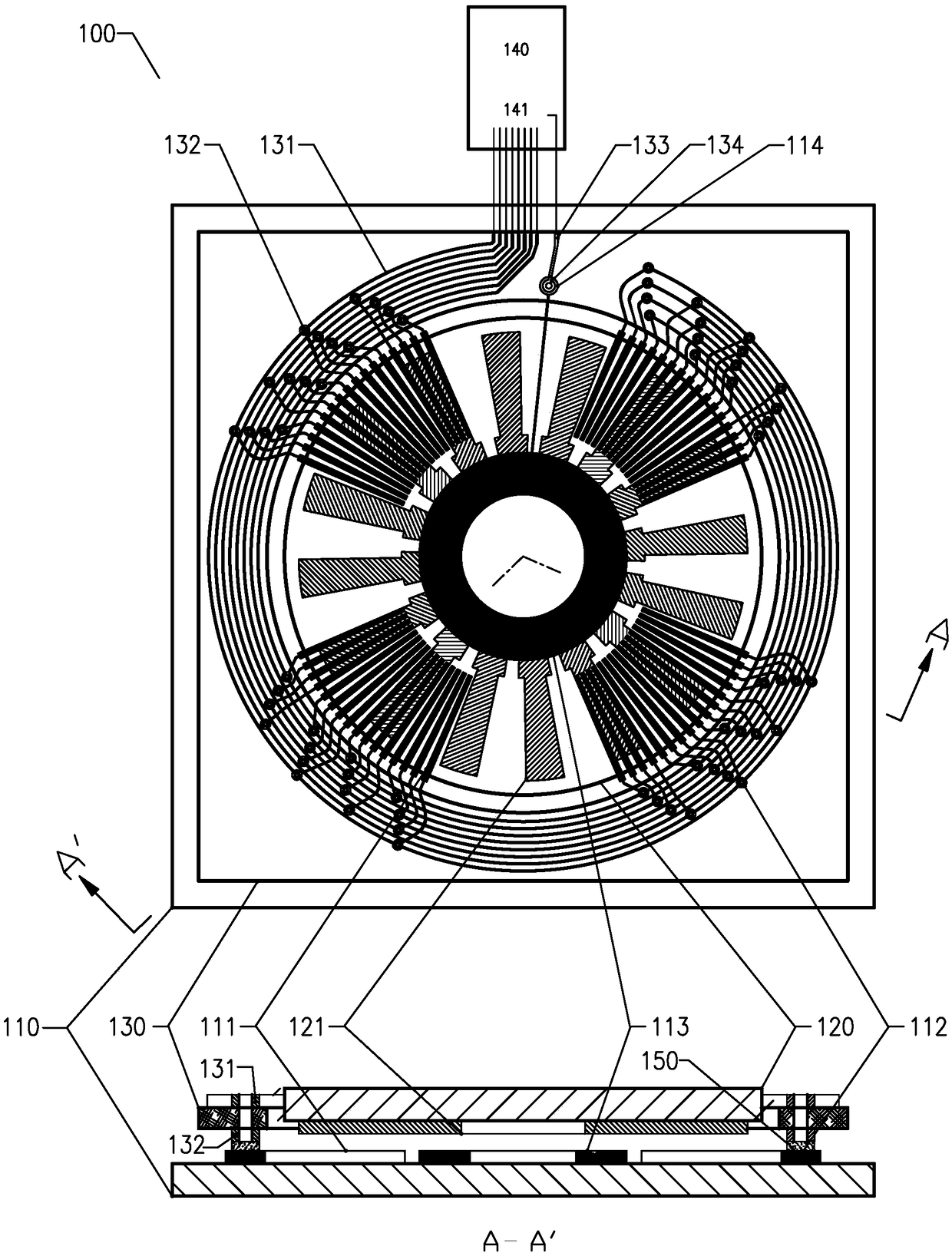A Multilayer Electrode Displacement Sensor
A displacement sensor, multi-layer electrode technology, applied in the field of sensors, can solve the problems of flexible FPC deformation, terminal alignment difficulties, etc., to save costs, avoid alignment difficulties, and improve compactness.
- Summary
- Abstract
- Description
- Claims
- Application Information
AI Technical Summary
Problems solved by technology
Method used
Image
Examples
specific Embodiment approach 1
[0038] Such as Figure 1a and Figure 1b The capacitive grid angular displacement sensor 100 shown includes an emitter electrode substrate 110 , a coupling electrode substrate 120 , a wiring board 130 and a detection circuit 140 . The emitter electrode substrate 110 is a glass substrate, and the grid-shaped emitter electrode group 111 and the receiver electrode 113 are prepared on the same surface of the emitter electrode substrate 110, and each emitter electrode of the grid-like emitter electrode group 111 has an emitter electrode lead-out terminal , the outgoing terminals of each transmitting electrode form the transmitting electrode outgoing terminal group 112, and the receiving electrode 113 has a receiving electrode outgoing terminal 114; the coupling electrode substrate 120 is also a glass substrate, and the grid-shaped coupling electrode group 121 is prepared on the coupling electrode substrate 120, the coupling electrode group 121 transmits the electrical signal on the...
specific Embodiment approach 2
[0042] Such as Figure 2a and Figure 2b The capacitive grid angular displacement sensor 200 shown includes an emitter electrode substrate 210 , a coupling electrode substrate 220 , a wiring board 230 and a detection circuit 240 . The emitter electrode substrate 210 is a glass substrate, and the grid-shaped emitter electrode group 211 and the receiver electrode 213 are prepared on the same surface of the emitter electrode substrate 210, and each emitter electrode of the grid-like emitter electrode group 211 has an emitter electrode lead-out terminal position respectively. , the outgoing terminals of each transmitting electrode form the transmitting electrode outgoing terminal group 212, and the receiving electrode 213 has a receiving electrode outgoing terminal 214; the coupling electrode substrate 220 is also a glass substrate, and the gear-shaped coupling electrode 221 is prepared on the coupling electrode substrate 220 On, the coupling electrode 221 transmits the electrica...
specific Embodiment approach 3
[0046] Such as Figure 3a and Figure 3b The capacitive grid angular displacement sensor 300 shown includes an emitter electrode substrate 310 , a coupling electrode substrate 320 , a wiring board 330 and a detection circuit 340 . The emitter electrode substrate 310 is a ceramic material substrate, and the grid-shaped emitter electrode group 311 and the receiver electrode 313 are prepared on the same surface of the emitter electrode substrate 310, and each emitter electrode of the grid-like emitter electrode group 311 has an emitter electrode lead-out terminal position respectively. , the outgoing terminals of each transmitting electrode form the transmitting electrode outgoing terminal group 312, and the receiving electrode 313 has a receiving electrode outgoing terminal 314; the coupling electrode substrate 320 is also a ceramic material substrate, and the grid-shaped coupling electrode group 321 is prepared on the coupling electrode substrate 320, the coupling electrode gr...
PUM
 Login to View More
Login to View More Abstract
Description
Claims
Application Information
 Login to View More
Login to View More - R&D
- Intellectual Property
- Life Sciences
- Materials
- Tech Scout
- Unparalleled Data Quality
- Higher Quality Content
- 60% Fewer Hallucinations
Browse by: Latest US Patents, China's latest patents, Technical Efficacy Thesaurus, Application Domain, Technology Topic, Popular Technical Reports.
© 2025 PatSnap. All rights reserved.Legal|Privacy policy|Modern Slavery Act Transparency Statement|Sitemap|About US| Contact US: help@patsnap.com



